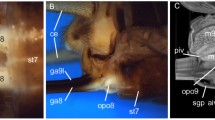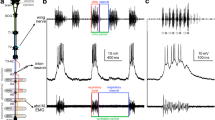Summary
The leech heartbeat consists of a constriction-dilation rhythm of two lateral heart tubes extending over the length of the body. The beats of the segmental sections of these two tubes are coordinated in such a manner that the heart tube of one body side produces a frontward peristaltic wave while the heart tube on the other body side produces nearly concerted constrictions. This rhythm is metastable, in that left and right heart tubes alternate between peristaltic and concerted constriction modes, with a given mode lasting for tens or hundreds of beat cycles.
The constriction-dilation cycles of the segmental heart tube sections are controlled by a set of rhythmically active motor neurons, the heart excitors, or HE cells. A bilateral pair of HE cells is located in all but the two frontmost and the two rearmost segmental ganglia of the ventral nerve cord. Each HE cell innervates via excitatory synapses the circular muscle fibers in the wall of the ipsilateral heart tube section. The activity cycle of the HE cells consists of an active phase, during which they are depolarized and produce a burst of impulses, and an inactive phase during which they are repolarized by a burst of inhibitory synaptic potentials. The intersegmentally coordinated activity cycles of the HE cell set are maintained in an isolated ventral nerve cord. Hence the generation of the heart excitor rhythm does not require sensory feedback.
Similar content being viewed by others
References
Boroffka, I., Hamp, R.: Topographie des Kreislaufsystems und Zirkulation beiHirudo medicinalis. Z. Morph. Tiere64, 59–76 (1969)
Gaskell, J.F.: VI. The chromaffine system of annelids and the relation of this system to the contractile vascular system in the leech, Hirudo medicinalis. A contribution to the comparative physiology of the contractile vascular system and its regulators, the adrenalin secreting system and the sympathetic nervous system. Phil. Trans. roy. Soc.205 B. 153–211 (1914)
Gaskell, J.F.: Adrenalin in annelids. J. gen. Physiol.2, 73–85 (1919)
Hammersen, F., Staudte, H.-W.: Beiträge zum Feinbau der Blutgefäße von Invertebraten. I. Die Ultrastruktur des Sinus lateralis vonHirudo medicinals. Z. Zellforsch.100, 215–250 (1969)
Kristan, W.B., Jr., Stent, G.S., Ort, C.A.: Neuronal control of swimming in the medicinal leech. I. Dynamics of the swimming rhythm. J. comp. Physiol.94, 97–149 (1974)
Mann, H.: Leeches. New York: Pergamon Press 1962
Muller, K.J., McMahan, U.J.: The arrangement and structure of synapses formed by specific sensory and motor neurons in segmental ganglia of the leech. Anat. Rec.181, 432P (1975)
Nicholls, J.G., Baylor, D.A.: Specific modalities and receptive fields of sensory neurons in CNS of the leech. J. Neurophysiol.31, 740–756 (1968)
Ort, C.A., Kristan, W.B., Jr., Stent, G.S.: Neuronal control of swimming in the medicinal leech. II. Identification and connections of motor neurons. J. comp. Physiol.94, 121–254 (1974)
Thompson, W.J., Stent, G.S.: Neuronal control of heartbeat in the medicinal leech. II. Intersegmental coordination of heart motor neuron activity by heart interneurons. J. comp. Physiol.111. 281–307 (1976)
Author information
Authors and Affiliations
Additional information
We are indepted to Amy Kelly and King-Wai Yau for advice on the use of the intracellular staining technique and to John Kretz for calling to our attention the existence of an afferent impulse burst rhythm emanating from denervated heart tube preparations. We thank Georgia Harper for excellent technical assistance. This research was supported by Grant GB 31933X from the National Science Foundation and NIH research grants GM17866 and Training Grant GM 01389 from the Institute of General Medical Sciences.
Rights and permissions
About this article
Cite this article
Thompson, W.J., Stent, G.S. Neuronal control of heartbeat in the medicinal leech. J. Comp. Physiol. 111, 261–279 (1976). https://doi.org/10.1007/BF00606468
Received:
Issue Date:
DOI: https://doi.org/10.1007/BF00606468




